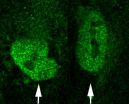(Press-News.org) NASA's Aqua satellite documented the formation of Tropical Storm Oswald in the Gulf of Carpentaria on Jan. 21 and the landfall on Jan. 22 in the southwestern Cape York Peninsula of Queenstown, Australia. Oswald has since become remnant low pressure area over land.
Tropical Storm Oswald was hugging the southwestern coast of the Cape York Peninsula, Queensland, Australia when NASA's Aqua satellite first flew overhead on Jan. 21 at 0430 UTC (Jan. 20 at 11:30 p.m. EST). The Moderate Resolution Imaging Spectroradiometer (MODIS) instrument aboard NASA's Aqua satellite captured a visible image of the storm that showed tight bands of thunderstorms. Those bands weakened the next day when MODIS captured a second visible image of the storm. At that time, Oswald's eastern quadrant was over land.
On Jan. 21 at 0600 UTC (1 a.m. EST), Oswald had maximum sustained winds near 35 knots (40 mph/64.8 kph). Oswald was centered near 15.8 south and 141.2 east, about 90 nautical miles (103.6 miles /166.7 km) east-northeast of Mornington Island, Australia. NASA MODIS imagery on Jan. 22 showed Oswald's center over the southwestern coast of the peninsula while monsoonal flow was bringing thunderstorms and heavy rainfall to the eastern side of the peninsula. Oswald's maximum sustained winds had dropped to 25 knots (28.7 mph/46.3 kph) on Jan. 22.
NASA also captured an infrared image of Tropical Storm Oswald on Jan. 22 at 0329 UTC with the Atmospheric Infrared Sounder (AIRS) instrument that also flies aboard NASA's Aqua satellite. AIRS data revealed cold cloud tops and strong storms associated with Oswald and a nearby monsoonal trough (elongated area of low pressure) stretched from Cairns north to Cooktown, and over Cape Melville and Lakefield National Parks on the eastern Cape York Peninsula.
At 0600 UTC (1 a.m. EST/U.S.) on Jan. 22, Oswald was downgraded to a remnant low pressure area. The center of circulation was located near 5.0 south latitude and 142.3 east longitude, about 185 nautical miles (213 miles/342.6 km) east-northeast of Mornington Island, Australia, and over the Cape York Peninsula. Infrared satellite data at that time showed the strongest storms were located in the northwestern quadrant. An image from NASA's Tropical Rainfall Measuring Mission (TRMM) satellite on Jan. 22 showed that the low-level center was now stretched across the Cape York Peninsula.
The Australian Bureau of Meteorology (ABM) noted at 10 p.m. Cairns local time (7 a.m. EST/U.S.), that ex-tropical Cyclone Oswald was located over eastern Cape York Peninsula approximately 70 km (43.5 miles) east of Cape Flattery. Oswald was moving southeast at 20 kph (12.4 mph). ABM noted that the monsoon trough (elongated area of low pressure) extended from the ex-tropical cyclone to the east coast near Cairns, which contain the storms that NASA's AIRS instrument saw.
ABM forecasts damaging winds, with gusts to 90 kph (56 mph) with showers and thunderstorms across Cape York Peninsula north of Cooktown. Locations which may be affected include Aurukun, Weipa, Torres Strait Islands, Lockhart River, Coen and Cooktown. Heavy rainfall is likely throughout the Peninsula district, coastal parts of the North Tropical Coast and Tablelands district, and coastal parts of the Herbert and Lower Burdekin district north of about Ayr. The heavy rainfall may also lead to flash flooding. For more information: http://www.bom.gov.au/cyclone/.
Forecasters expect Oswald to linger over the Cape York Peninsula and the Joint Typhoon Warning Center expects Oswald's remnants to continue tracking over land to the southeast.
INFORMATION:
NASA sees Tropical Cyclone Oswald weaken over Queensland's Cape York Peninsula
2013-01-23
ELSE PRESS RELEASES FROM THIS DATE:
Bacterial supplement could help young pigs fight disease
2013-01-23
Jan. 22, 2013 - A common type of bacteria may help pigs stay healthy during weaning.
In a study of 36 weanling-age pigs, researchers found that a dose of lipid-producing Rhodococcus opacus bacteria increased circulating triglycerides. Triglycerides are a crucial source of energy for the immune system.
"We could potentially strengthen the immune system by providing this bacterium to animals at a stage when they are in need of additional energy," said Janet Donaldson, assistant professor in Biological Sciences Mississippi State University. "By providing an alternative ...
Novel gene-searching software improves accuracy in disease studies
2013-01-23
A novel software tool, developed at The Children's Hospital of Philadelphia, streamlines the detection of disease-causing genetic changes through more sensitive detection methods and by automatically correcting for variations that reduce the accuracy of results in conventional software. The software, called ParseCNV, is freely available to the scientific-academic community, and significantly advances the identification of gene variants associated with genetic diseases.
"The algorithm we developed detects copy number variation associations with a higher level of accuracy ...
Disease outbreaks trackable with Twitter
2013-01-23
This flu season you've probably seen a number of friends on social media talking about symptoms.
New research from Brigham Young University says such posts on Twitter could actually be helpful to health officials looking for a head start on outbreaks.
The study sampled 24 million tweets from 10 million unique users. They determined that accurate location information is available for about 15 percent of tweets (gathered from user profiles and tweets that contain GPS data). That's likely a critical mass for an early-warning system that could monitor terms like "fever," ...
Gay African-American youth face unique challenges coming out to families
2013-01-23
NEW BRUNSWICK, N.J. – Coming out to one's family can be stressful, but gay black males face a unique set of personal, familial and social challenges.
"Parents and youths alike worry that gay men cannot meet the rigid expectations of exaggerated masculinity maintained by their families and communities," says Michael C. LaSala, director of the Master of Social Work program at Rutgers University School of Social Work. LaSala, an associate professor, recently completed an exploratory study of African American gay youth and their families from urban neighborhoods in New York ...
Stem cell research helps to identify origins of schizophrenia
2013-01-23
BUFFALO, N.Y. – New University at Buffalo research demonstrates how defects in an important neurological pathway in early development may be responsible for the onset of schizophrenia later in life.
The UB findings, published in Schizophrenia Research (paper at http://bit.ly/Wq1i41), test the hypothesis in a new mouse model of schizophrenia that demonstrates how gestational brain changes cause behavioral problems later in life – just like the human disease.
Partial funding for the research came from New York Stem Cell Science (NYSTEM).
The genomic pathway, called the ...
Black patients with hypertension not prescribed diuretics enough
2013-01-23
NEW YORK (January 22, 2013) -- A research study of more than 600 black patients with uncontrolled hypertension found that less than half were prescribed a diuretic drug with proven benefit that costs just pennies a day, report researchers at Weill Cornell Medical College and the Visiting Nurse Service of New York's (VNSNY) Center for Home Care Policy and Research. The researchers say these new findings should be taken as a serious wake-up call for physicians who treat black patients with hypertension.
Their study, reported in the American Journal of Hypertension, found ...
2013 Gastrointestinal Cancers Symposium reveals new advances for GI cancers
2013-01-23
ALEXANDRIA, Va. – New research into the treatment and prognosis of gastrointestinal cancers was released today in advance of the tenth annual Gastrointestinal Cancers Symposium being held January 24-26, 2013, at The Moscone West Building in San Francisco, CA.
Five important studies were highlighted today in a live presscast:
Postoperative Treatment with S-1 Chemotherapy Reduces Relapses and Extends Survival in Patients with Pancreatic Cancer: Early results from a Phase III clinical trial conducted in Japan show patients who received the chemotherapy drug S-1 after ...
UT MD Anderson scientists find protein that reins in runaway network
2013-01-23
HOUSTON — Marked for death with molecular tags that act like a homing signal for a cell's protein-destroying machinery, a pivotal enzyme is rescued by another molecule that sweeps the telltale targets off in the nick of time.
The enzyme, called TRAF3, lives on to control a molecular network that's implicated in a variety of immune system-related diseases if left to its own devices.
The University of Texas MD Anderson scientists identified TRAF3's savior and demonstrated how it works in a paper published online Sunday in Nature.
By discovering the role of OTUD7B as ...
NYUCN's Drs. Shedlin and Anastasi publish in the Journal of the Association of Nurses in AIDS Care
2013-01-23
New York University College of Nursing (NYUCN) researchers Michele G. Shedlin, PhD, and Joyce K. Anastasi, PhD, DrNP, FAAN, LAc, published a paper, "Use of Complementary and Alternative Medicines and Supplements by Mexican-Origin Patients in a U.S.–Mexico Border HIV Clinic," in the on-line version of the Journal of the Association of Nurses in AIDS Care.
Complementary and alternative medicines (CAM) and therapies are often used to improve or maintain overall health and to relieve the side effects of conventional treatments or symptoms associated with chronic illnesses ...
TGen, Scottsdale Healthcare study shows drug combination extends pancreatic cancer patient survival
2013-01-23
SCOTTSDALE, Ariz. — Jan. 22, 2013 — A multi-center Phase III clinical trial demonstrates that Abraxane (nab-paclitaxel) plus gemcitabine is the first combination of cancer drugs to extend survival of late-stage pancreatic cancer patients compared to standard treatment.
The MPACT (Metastatic Pancreatic Adenocarcinoma Clinical Trial) study was led by physicians from Scottsdale Healthcare's Virginia G. Piper Cancer Center Clinical Trials, a partnership between Scottsdale Healthcare and the Translational Genomics Research Institute (TGen).
Their findings show that Abraxane ...

